|
|
| |
instep analysis
Mirror mirror on the wall, who's the fairest
of them all?
Whether it's the National Selection Panel, the Advisory Board,
or even the final list of selected designers for Pakistan Fashion
Week that'll be announced in another two weeks time, can the industry
rest assured that Pakistan is actually putting its best foot forward?
Moreso, will the process be fair?
By Aamna Haider Isani
|
| |
| The
first fashion show of Pakistan Fashion Week is scheduled to roll in
at 12:00 pm, November 5, 2007 at the Royal Palm Golf and Country Club
Lahore. Which designer will be slotted for that time can't be said
yet, but whoever it is will go down in Pakistan's fashion history
as someone who inaugurated the first fashion week. It will be a historical
moment in time that'll definitely be riddled with high anxiety and
adrenalin. But it will be compensated for achieving what was, until
a couple of years ago, something as inconceivable in this country
as sincere leadership. |
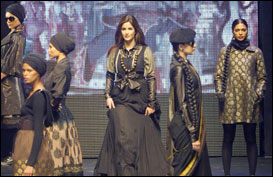 |
| |
|
It's always tough to push a heavy ball of iron uphill
but once it reaches the top, it comes down with uncontrollable speed
and that is what has happened with Pakistan Fashion Week. In another
five days, on July 20, the time limit for submitting application
forms will end; the National Selection Panel will evaluate portfolios
on August 1, recommend them to the PFW Advisory Board on the same
day, call for confirmations on August 2 and 3 and on August 13 announce
the final list of designers who will be showing. That list will
be a nail biting end to a match that is being played for decades
between the pioneers of fashion and the young graduates, between
Lahore based designers and those settled in Karachi and between
the couturiers and those few brave hearts who have been doing prêt.
It will be nail biting, quite like the day results are announced
after examinations. The examiners are those nine members of the
National Selection Panel who will be analyzing the submitted portfolios.
|
| |
Can
this National Selection Panel be unbiased?
The Panel: Jodi Pritchard (IMG world), Nabila (Image consultant
and stylist, Karachi), Muniba Kamal (Editor, Instep, Karachi), Sabene
Saigol (Editor, Libas International, Lahore), Tapu Javeri (Photographer,
Karachi), Azfar Hassan (Industrialist, Lahore), Shamaeel (Retailer,
Karachi), Asim Naeem (Representative, Pakistan School of Fashion
Design, Lahore) and Asim Amjad (Representative, Asian Institute
of Fashion Design, Karachi).
Except for the
Asim Amjad and Asim Naeem, who are both known to be silent workers,
everyone on this panel has a strong and very loud voice. There is
an undeniable tilt towards Karachi, as far as logistical representation
is concerned, but the figureheads are known to be fair. Nabila works
in both cities so cannot afford to be biased towards any one. And
with Jodi Pritchard undoubtedly holding the highest powers of a
neutral umpire, the remaining team nicely balances out.
|
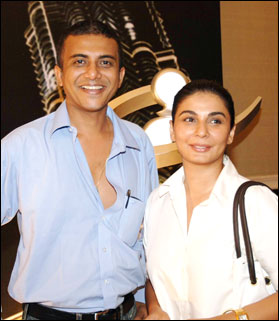 |
| |
| Pritchard
comes with vast international experience since she has been heading
IMG's International Marketing. And what goes to Pakistan's advantage
is that she has been deeply involved with the development of Beijing
International Fashion Festival, Luxury Week Hong Kong and EcoStyle
in Kuala Lumpur. Though Pakistani fashion really doesn't have anything
in common with fashion in the Far East, the very fact that this panelist
has been exposed to a global spectrum and doesn't essentially come
with an inflexible western palette is an added advantage. At this
point Pakistan desperately needs people who come in with a credible
reputation for being able to assimilate indigenous aesthetics of a
region with what the international market demands. |
| |
Sabene Saigol
and Tapu Javeri, along with the previously mentioned members, bring
solid understanding and a modern vision of Pakistani fashion to the
table. And Azfar Hassan and Shamaeel step in with the much required
business acumen. Perfect.
Everyone should be happy with this selection, except those who have,
until now, taken pride in designing 'bridal wear/trousseau wear' more
than anything else. With these people on the board, there will definitely
be no room for the Anarkalis of Pakistan at PFW. Nabila alone will
be able to raise a voice loud enough to ensure that. If there's any
one agenda that will be followed at meetings, it'll definitely be
a ploy to abolish the bridal and promote new and avant garde designers! |
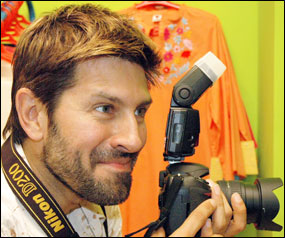 |
| |
|
For reasons
that are not unknown, there are no designers on the panel. After
all, through general dealing, internal industry politics, and the
tug of wars witnessed in the last five years of the Lux Style Awards,
designers have proven that they are in general, incapable of absolute
fairness. Plus, it would be unethical to expect one designer to
evaluate the other. One assumes it is the same all over the world
not just in Pakistan. To sum it up, this selection panel will be
unbiased, as long as it's not evaluating bridals, which in fact
are not even legible for participation!
|
| |
Exactly
what role does the Advisory Board play?
The board: Imran Aslam (President Geo TV Network), Simon Lock (CEO
IMG Fashion and Models Asia Pacific), Asim Qureshi (CEO Events Unlimited),
Maheen Khan (Chairperson and representative, Fashion Pakistan), Sehyr
Saigol (Publishing Director Libas International and representative,
Pakistan Fashion and Design Council), Sonya Battla (Independent Designer),
Nabila (Image Consultant and Stylist), Zahir Rahimtoola (Fashion Retailer),
Tehseen Shaukat (Jang Group) and Muniba Kamal (Editor Instep and representative,
Media) |
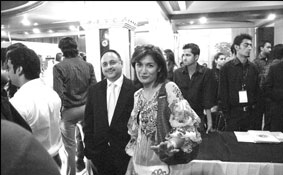 |
| |
The
National Selection Panel will have the clear cut job of selecting
designers who can and should show at Pakistan Fashion Week, but exactly
what role does the Advisory Board play in this event? The Jang Group,
IMG and Events Unlimited placed in that order establish the order
of hierarchy. Then there's representation from the two fashion councils
as well as an independent designer and an additional set of people
that are merited with knowing the fashion industry inside out. But
what is their role? Logically the first thing that comes to mind is
that the Advisory Board can and will be expected to ensure that Pakistan
Fashion Week takes place as a world class event.
"The Advisory Board will help in structuring Pakistan Fashion
Week," says Imran Aslam. "It will overlook the entire process
from venue selection to model search and everything else that comes
within the ambit of fashion. The idea is to open communication and
make this process transparent. We're not just sitting here to endorse
it; it's not just a rubber stamp. The idea is that the industry should
be involved."
That is exactly why designers have been taken on board as Advisors
to Pakistan Fashion Week. |
| |
And where
the fashion industry steps in
The Participation Kit that has been handed out to designers includes
the criteria for the selection process and the application form. As
a neutral observer it gives one great pleasure to finally see the
line between designers and darzis and bridals and couture clearly
demarcate the two as far apart as possible. In a nutshell, 'designers'
will be able to meet almost all requirements whereas others who have
been lucratively operating from homes, will not. This is the right
time for all those individuals who believe that they have potential
but have been lazing away from the limelight, to step up.
The Selection Criteria states that "80 per cent of the designs
on the catwalk (are) to be available for reproduction in international
sizing (ie ready to wear)". |
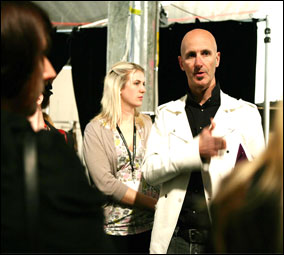 |
| |
| Out
of all designers in Pakistan, only those who make R2W clothing for
stores have ever thought about this and the 'small, medium, large'
labels that they have given for the convenience of the average Pakistani
buyer will easily translate to international sizing. According to
Hassan Sheheryar Yasin, "Our small, medium and large are sizes
8, 10 and 12 so it'll be as simple for us as translating the labels.
International sizing is an impressive word but every design house
has its own sizing. A Zara size 4 won't be the same as a Gucci size
4. As long as your sizes are consistent. " |
| |
Sonya Battla
is one of the few designers who has actually been following proper
gradations for the past few years. However, those who have created
a system for themselves, like HSY, Karma, Sublime, Nomi Ansari, Deepak
Perwani should be able to switch easily. As for the rest, especially
those who have been doing business on a "by appointment only"
method need to decide which road they want to take now.
One riddle that has been mystifying the industry for so long is going
to be resolved now. For the longest time, bridal designers have been
erroneously been calling themselves couturiers in Pakistan. But the
form clearly dictates that couture is permitted onto the PFW forum,
whereas bridals are "not applicable". That puts most designers
in quite a predicament and they will be in a rush to decide whether
they can apply in that category or not. |
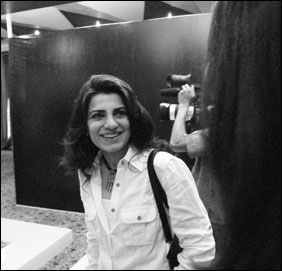 |
| |
| Couture
has to deviate from the gharara sharara silhouette. Not every made
to order ensemble marked above the one hundred thousand rupee price
mark qualifies as couture. As with prêt a porter, it is the
experimentation with silhouette and coming up with a trademark signature
that qualifies as couture. And that signature cannot be established
by embellishment alone. Nilofer Shahid does couture, Rizwan Beyg does
couture and Saadia Mirza does couture. Even Sana and Safinaz are capable
of doing it brilliantly, though they haven't shown enough of their
potential recently. Many other prolific designers may be making beautiful
clothes but they are grades and stages of bridals. |
| |
| International
designers do present bridals as part of their couture collections.
Recently at Rome Fashion Week couturiers like Fausto Sarli have brought
on white wedding gowns in the finale. So are bridals acceptable so
long as they wear a western stamp? The thing is that a gown is versatile;
it can play with the silhouette as well as embellishment. But ethnic
bridals depend wholly the embellishment that goes on them. Even if
local designers have been trying to play around with the shape of
the lehnga, no one will buy it if it is presented in its natural form,
sans embroidery. That doesn't apply to the western bridal. It also
boils down to the time taken to manufacture these clothes. Fashion
Week orders are about delivering on time and with the average Pakistani
bridal taking a couple of months per piece, it's no wonder that they're
off limits. Now one wonders how designers will reinterpret couture! |
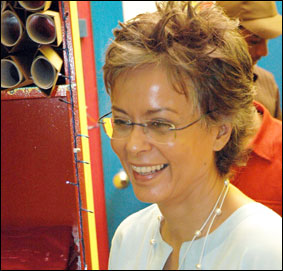 |
| |
|
Lastly, the
cost of showing at Pakistan Fashion Week has some designers squealing
in their seats. An individual collection show (seating 750 people)
will cost 5500 dollars, a smaller individual show (seating 250 people)
will cost 3500 dollars and a Group show will cost 2000 dollars.
So that's basically anything between 120 and 330 thousand rupees,
depending on how big you want to show. It's steep, but when you
look into everything you get for that price, it's actually cheap.
In the larger shows, designers will be provided with everything
from the venue, models, backstage equipment, cleaning and security
arrangements, sound and lighting, hair and makeup, even ushers and
everything that possibly goes into a show without the headache of
having to organize any of it yourself. Even the smaller shows offer
all that.
The Pakistan Fashion Week website is up and a fairly decent system
has been implemented to ensure that the show is as good as it can
get in Pakistan. Now it really is up to the designers. There's no
doubt that IMG can put up a good show but what use is brilliant
lighting if it doesn't fall upon equally brilliant collections?
After all, you can't expect a great show without the best designers.
|
| |
|

